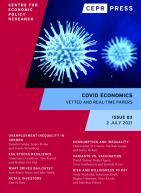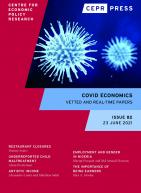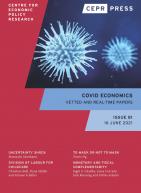
The Covid-19 health crisis has led to a substantial increase in work done from home, which shifts economic activity across geographic space. We refer to this shift as a Zoomshock. The Zoomshock has implications for locally consumed services; the clientèle of restaurants, coffee bars, pubs, hair stylists, health clubs located near workplaces now demand those services near where they live. In this paper, we measure the Zoomshock at a granular level for UK neighbourhoods. We establish three important empirical facts. First, the Zoomshock is large; many workers can work-from-home and live in a different neighbourhood than they work. Second, the Zoomshock is very heterogenous; economic activity is decreasing in productive city centres and increasing residential suburbs. Third, the Zoomshock moves workers away from neighbourhoods with a large supply of locally consumed services to neighbourhoods where the supply of these services is relatively scarce. We discuss the implications for aggregate employment and local economic recovery following the Covid-19 pandemic.
Citation
Matheson, J, J Rockey and G De Fraja (2021), ‘Zoomshock: The geography and local labour market consequences of working from home‘, COVID Economics 64, CEPR Press, Paris & London. https://cepr.org/publications/covid-economics-issue-64#392514_392940_390696
Relying on a novel dataset covering more than 120,000 firms in 60 countries, this paper contributes to the debate about policies to support businesses through the COVID-19 pandemic. While governments around the world have implemented a wide range of policy support measures, evidence on the reach of these policies, the alignment of measures with firm needs, and their targeting and effectiveness remains scarce. This paper provides the most comprehensive assessment to date of these issues, focusing primarily on the developing economies. It shows that policy reach has been limited, especially for the more vulnerable firms and countries, and identifies mismatches between policies provided and policies most sought. It also provides some indicative evidence regarding mistargeting of policies and their effectiveness in addressing liquidity constraints and preventing layoffs. This assessment provides some early guidance to policymakers on tailoring their COVID-19 business support packages and points to new directions in data and research efforts needed to guide policy responses to the current pandemic and future crises.
Citation
Ortega, S, J Torres, D Medvedev, G Nayyar, J Lopez, F Maduko, L Iacovone, A Grover, E Davies, M Cruz and X Cirera (2021), ‘Policies to support businesses through the COVID-19 Shock: A Firm Level Perspective‘, COVID Economics 64, CEPR Press, Paris & London. https://cepr.org/publications/covid-economics-issue-64#392514_392940_390697
We find UK “local lockdowns†of cities and small regions, focused on limiting how many people a household can interact with and in what settings, are effective in turning the tide on rising positive COVID-19 cases. Yet, by focusing on household mixing within the home, these local lockdowns have not inflicted the large declines in consumption observed in March 2020 when the first virus wave and first national lockdown occurred. Our study harnesses a new source of real-time, transaction-level consumption data that we show to be highly correlated with official statistics. The effectiveness of local lockdowns are evaluated applying a difference-in-difference approach which exploits nearby localities not subject to local lockdowns as comparison groups. Our findings indicate that policymakers may be able to contain virus outbreaks without killing local economies. However, the ultimate effectiveness of local lockdowns is expected to be highly dependent on co-ordination between regions and an effective system of testing.
Citation
Guttman-Kenney, B and J Gathergood (2021), ‘The English Patient: Evaluating Local Lockdowns Using Real-Time COVID-19 & Consumption Data‘, COVID Economics 64, CEPR Press, Paris & London. https://cepr.org/publications/covid-economics-issue-64#392514_392940_390698
Empirical work described in this paper explains the daily evolution of the reproduction rate, R, and mobility for a large sample of countries, in terms of containment and public health policies. This is with a view to providing insight into the appropriate policy stance as countries prepare for a potentially protracted period characterised by new infection waves. While a comprehensive package of containment measures may be necessary when the virus is widespread and can have a large effect on reducing R, they also have effect on mobility and, by extension, economic activity. A wide-ranging package of public health policies – with an emphasis on comprehensive testing, tracing and isolation, but also including mask-wearing and policies directed at vulnerable groups, especially those in care homes – offer the best approach to avoiding a full lockdown while containing the spread of the virus. Such policies may, however, need to be complemented by selective containment measures (such as restricting large public events and international travel or localised lockdowns) both to contain local outbreaks and because implementing some of the recommended public health policies may be difficult to achieve or have unacceptable social costs.
Citation
Turner, D, Y Guillemette, F Murtin and B Égert (2021), ‘Walking the tightrope: Avoiding a lockdown while containing the virus‘, COVID Economics 64, CEPR Press, Paris & London. https://cepr.org/publications/covid-economics-issue-64#392514_392940_390699
Overall mobility declined during the COVID-19 pandemic because of government lockdowns and voluntary social distancing. Yet, aggregate data mask important heterogeneous effects across segments of the population. Using unique mobility indicators based on anonymized and aggregate data provided by Vodafone for Italy, Portugal, and Spain, we find that lockdowns had a larger impact on the mobility of women and younger cohorts. Younger people also experienced a sharper drop in mobility in response to rising COVID-19 infections. Our findings, which are consistent across estimation methods and robust to a variety of tests, warn about a possible widening of gender and inter-generational inequality.
Citation
Spilimbergo, A, F Grigoli, D Sandri and F Caselli (2021), ‘Mobility under the COVID-19 Pandemic: Asymmetric Effects across Gender and Age‘, COVID Economics 64, CEPR Press, Paris & London. https://cepr.org/publications/covid-economics-issue-64#392514_392940_391062
We analyse the short-term impact of social distancing measures on the US labour market, using a panel threshold model with high frequency (weekly) data on unemployment across US states. We find that changes in the restrictiveness of mandated social distancing, as measured by the Oxford Stringency Index, exert a strong immediate impact on initial unemployment. Â The unemployment rate is not immediate affected but follows within a very short time (two to four weeks). We also document a substantial asymmetry between tightening and easing: the impact of tightening restrictions is twice as large as that of easing them. The state of the endemic, proxied either by cases or fatalities, constitutes a marginal factor.
Citation
Gros, D and C Dreger (2021), ‘Lockdowns and the US unemployment crisis‘, COVID Economics 64, CEPR Press, Paris & London. https://cepr.org/publications/covid-economics-issue-64#392514_392940_390700
This paper is meant to present an overview of what economists have analyzed regarding the implications of two of the main components of the Coronavirus Aid, Relief, and Economic Security (CARES) Act that impact individuals: the increased UI benefits and the stimulus checks. We present the findings from the literature on these two policies implemented in the United States with an eye on potential future governmental interventions.
Citation
Nygaard, V and E Falcettoni (2021), ‘A Literature Review on the Impact of Increased Unemployment Insurance Benefits and Stimulus Checks in the United States‘, COVID Economics 64, CEPR Press, Paris & London. https://cepr.org/publications/covid-economics-issue-64#392514_392940_390701


Covid Economics - Issue 82
- Restaurant Closures during the Pandemic: A Descriptive Analysis
- Underreporting Child Maltreatment during the Pandemic: Evidence from Colorado
- Covid-19 impact on Artistic Income
- COVID-19, Employment, and Gender: Evidence from Nigeria
- The Importance of Being Earners: Modelling the Implications of Changes to Welfare Contributions on Macroeconomic Recovery
